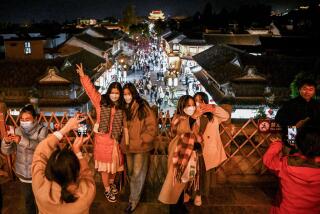Dalian Rises Again as Japanese Hub
DALIAN, China — At the Beautiful Club, a dimly lighted basement karaoke bar here, silk-gowned Chinese hostesses wait on Japanese businessmen who have some yen for company.
In the penthouse restaurant of the Senmao Building, an imposing new marble-and-glass skyscraper constructed by Mori Building Co. of Tokyo, Japanese diners linger over elegant courses of yellowtail sushi and sea urchins.
At the new Golden Pebble Beach Golf Club north of town, Japanese golfers--who pay a membership fee of $70,000 for the privilege--tee off on a rocky shoreline course designed to look and play like the challenging Northern California links for which the club is named.
The Japanese are back.
From 1905 until the end of World War II, Dalian was the overseas pearl of imperial Japan, which won the seaport from Russia in the Russo-Japanese War.
At the peak of Dalian’s colonial era, 300,000 Japanese lived here, many in the European-style villas on the hills above the city center. The Dalian train station is an exact replica of Ueno Station in Tokyo. The courthouse was a replica of Yasudo Kodo Auditorium at Tokyo University.
Arriving air passengers could see “Big Japan” spelled out in giant characters on the rooftops of the picturesque city on the tip of the Liaodong peninsula.
Today, the city famed for its ice-free deep-water port has reemerged as Japan’s cultural and economic beachhead on the Chinese mainland.
Dalian, home to about 4,000 Japanese expatriates, is key to Japan’s campaign to win a portion of the giant China market--a campaign that it seems to be winning on many fronts.
According to the Chinese government’s estimates for 1996, Japan is China’s biggest foreign trading partner, followed by the United States, Hong Kong and the European Union.
Despite vestiges of bitterness over Japan’s World War II aggression, China’s growing consumer class rates Japanese products above all others. According to a 1995 Gallup Organization survey of consumer attitudes, six of the top 10 foreign brands identified by consumers are Japanese.
Only three American brand names--Coca-Cola, Mickey Mouse and Marlboro--made the list. Meanwhile, the four best-known Japanese brands--Hitachi, Toshiba, Toyota and Panasonic--also had the highest product-quality ratings.
While winning a substantial chunk of the emerging market, Japan has largely avoided providing China with the technology transfers that have characterized U.S. and European investments in China.
“In general,” said Anne Stevenson-Yang, director of the Beijing office for the U.S.-China Business Council, “the Japanese have been very reluctant to transfer technology. They view China as a potential competitor, which most U.S. businesses do not.”
Meanwhile, Japan’s low-key approach on human rights issues wins points with the Beijing leadership, which has been angered in the past by U.S. efforts to link trade with the issue.
Chasing the market, some of the Japanese new investment in the past two years has shifted from the Dalian area to the richer, more densely populated region of the Yangtze River delta surrounding Shanghai. Investors estimate that in a few years, the river basin will have developed a consumer population of more than 200 million financially capable of buying basic goods.
“China was initially seen as a factory to make goods for export,” Hiroji Tate, general manager of Marubeni Investment Firm in Shanghai, said in an interview with the South China Morning Post. “Today it is seen as a vast market.”
Beginning in 1994, said Shuichi Umezawa, general manager of the Bank of Tokyo office here, Japanese investment in Shanghai surpassed Dalian in terms of the number of new companies and volume of new investment.
But 30% of all Japanese investment remains in this city of 5.3 million. Japanese companies and joint ventures produce more than 70% of all the city’s exports.
It is here in Dalian--once one of Japan’s greatest overseas military bases and home of the Manchurian Railroad--that legions of Japanese business people and tourists find the most Japan-friendly environment in China. Among the tourists are the 16,000 aging members of the Tokyo-based Dalian Assn., who frequently return to the city to visit their childhood homes and schools.
“The Japanese know every niche and stone of Dalian,” said a senior government official in Beijing. “They considered it their fifth province.” Many elderly Chinese residents of Dalian still speak Japanese.
More than perhaps any other place in China, Dalian tends to be forgiving of Japanese military excesses during the long occupation and World War II.
“Historically,” said Li Wengfang, a young city trade official, “Dalian and the Japanese people have things to regret. But if we kept thinking about history we would have no cooperation, no progress. In the end, we can’t blame the grandson for the sins of the grandfather.”
Sun Meili, a 20-year-old hostess in the Beautiful Club, seemed to agree. “I am too young to remember the bad things the Japanese did,” she said. “My parents are too young to remember. Maybe my grandparents remember.”
The city boasts dozens of Japanese restaurants--including at least four that rival top restaurants in Japan--as well as karaoke clubs and bathhouses. Many of the Japanese-era buildings in the city have been restored, including the stately Japanese bank buildings that surround present-day Zhongshan Plaza.
Last year in Dalian, the expatriate Japanese opened a school for their children. There are 15 flights weekly from Dalian to Japan.
The Japanese Consulate, opened three years ago, is housed in a villa once occupied by a colonel in the Japanese Imperial Army.
For Hideo Watanabe, Japan’s consul here, the turning point in Dalian’s livability for Japanese came last summer, when play began on two new golf courses.
“After those two golf courses opened last summer,” said a smiling Watanabe, interviewed in his office as a Japanese news channel played on a television set in the corner, “our living conditions really improved.”
(BEGIN TEXT OF INFOBOX / INFOGRAPHIC)
Japan’s Economic Beachhead in China
Dalian, once the overseas pearl of imperial Japan, has reemerged as Tokyo’s cultural and economic foothold in China.
China’s Trading Partners (Billions of dollars)
Japan: $60.1
U.S.: $42.8*
Hong Kong: $40.7
European Union: $39.7
South Korea: $20
Taiwan: $19.7
Singapore: $7.3
Russia: $6.9
****
Note: 1996 figures
* Because of China’s calculation methods, U.S.-China trade figures do not match figures from the Department of Commerce. The U.S. department estimates U.S.-China trade in 1996 at more than $60 billion.
Sources: China’s Ministry of Foreign Trade and Economic Cooperation, Wenhui Daily in Hong Kong
More to Read
Sign up for Essential California
The most important California stories and recommendations in your inbox every morning.
You may occasionally receive promotional content from the Los Angeles Times.










